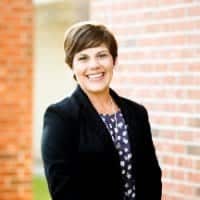The pioneer institution of online and blended learning is Florida Virtual School (FLVS). Although it started as a virtual classroom for students of the Sunshine State, it has quickly reached across the nation and beyond to 65 other countries. Helping lead the expansion charge is Dr. Polly Haldeman, FLVS’s Chief Customer Officer.

While FLVS is evolving from a blended learning platform for public school students to a multi-national curriculum licensing operation, Polly is helping to lead the charge with students, parents, and institutions using their curriculum. When asked about the content created by FLVS, Polly says, “What we have is quality, rigorous, and full of integrity; and it’s built upon the principles of educators and all the great things that we know that we should do for kids.”
Polly is a Florida native who grew up in a rural area, where she graduated high school with a class of 13 students. She earned a Bachelor’s Degree, Master’s Degree, a Specialist of Education in Teacher Leadership, and a Doctorate of Education. She has been with FLVS for nearly 14 years and has grown with it through all the changes that have happened over that time. All indicators point to Polly leading FLVS into an even brighter global education future.
Interview Transcript:
Dr. Berger: Polly, it’s nice to spend some time with you today. I’m continuing to get very interested in what we’re doing globally. I think what’s compelling about Florida Virtual is its origins in the State of Florida and how that has expanded to provide services and opportunities around the world when we’re thinking about ministries of education and groups that are trying to understand virtual education, blended environments and satellite campuses.
With that as the backdrop, what is it like to be in charge of and to work on the global scene with regards to Florida Virtual and how has that changed since your time being at Florida Virtual?
Dr. Polly Haldeman: I’ve been with Florida Virtual for almost 14 years, so I have a good perspective on the changes, the growth, the implementation, and just a lot of different viewpoints. I think that the greatest thing in having a global audience is that we can partner and learn from a variety of different implementation models; and specific learning needs that are addressed by our global clients are things that we can take back and learn from, too.
It’s not just all about what we do and how well we do it and sharing that. It’s about that exchange back and forth of best practices and all the things that are going to benefit kids at the end of the day.
DB: Tell me a little bit about where Florida Virtual is at when we’re thinking about the growth globally. How many countries is Florida Virtual in and what is the appetite for a virtual learning environment?
PH: Today, we’re in 65 countries ─ and it could be in a variety of different ways. Obviously, we have our global school so students can come on a tuition basis and take courses from us just like what our Florida students do as part of the state’s public education system.
Globally, they come, and they take a course or two. Mostly, though, our business is in the area of licensing our content to other school districts, schools and, and even states.
Educational centers, there’s a variety of different customers’ profiles that license content for whatever ─ they’re virtual (or blended, now, even) needs are.
So I think that is the area in which we see the growth.
DB: What does it say about the market that they are reaching out wanting to license the content? I think a lot of people thought that they could figure it out but it takes a lot of time and money and research and to review that research and application to follow that through. Is that part of the reason why you think people said, “You know what, who’s been doing it the longest and who knows what they’re doing?”
 PH: “Why reinvent the model when they created the model?” is what we really hear. We welcome folks to do what they think is in the best interest of their students but what we’ve found is that we do it pretty well.
PH: “Why reinvent the model when they created the model?” is what we really hear. We welcome folks to do what they think is in the best interest of their students but what we’ve found is that we do it pretty well.
What we have is quality, rigorous, and full of integrity; and it’s built upon the principles of educators and all the great things that we know that we should do for kids. And you really can’t go wrong there.
But I think one of the common things I hear from my position is that folks go and try to develop, but they forget about the maintenance of that development or the idea that you can use open-ed resources for so long, and then you might need more, and then you’ve got the license things and then you’ve got copyright things.
There’s just a lot to it, and we have spent twenty years doing just that. So we become natural at it, so to speak. And so, why don’t you take your program and implement it the way that you need to and we’ll take care of the content?
DB: A lot of people want to try to predict where education is going, and that makes for a great fodder for discussion at conferences and Twitter chats and the like.
But I would think that from your position and you start to see what’s going on based on the questions that you receive from other countries or states that are looking to license content that if you really had to, you might be able to make not just a prediction but sort of color in some of the lines with where we may be going and understanding the people’s concern which is “Is something going to be always, exclusively virtual? Is it going to be blended? How do we preserve what we have with brick and mortar and accentuate the positives?”
Where do you stand in that not to sort of say that you’ve got to have one opinion but, I guess, that you would see some things that might be some markers we can all take from an industry perspective?
 PH: From a personal and professional perspective, I’ve always been a fan of online learning simply because of the access. I’ve grown up in rural Florida. I would graduate from the smallest public high school in the state of Florida a class of 13 kids ─ yeah, really really small.
PH: From a personal and professional perspective, I’ve always been a fan of online learning simply because of the access. I’ve grown up in rural Florida. I would graduate from the smallest public high school in the state of Florida a class of 13 kids ─ yeah, really really small.
I didn’t have access to anything more than the other 12 kids that needed whatever course we were taking. I didn’t get advanced math; I didn’t get all these foreign languages beyond the Spanish every other year.
So that’s why it started the way it did for me, personally.
But what I’ve noticed is that we had to move too far beyond. It’s really about access, and that access doesn’t necessarily have to mean that you’re either all or nothing, virtual or not.
I hate to be cliché because it sounds like “blended” is the word of the day, but it really is being able to maximize access opportunities for kids in the way that they need it.
And the school districts and schools and parents should all have a say in that, and we enable the facilitation of that much, much easier. We don’t have to draw a line in the sand that “Here’s the way it’s going to be forever and always.” Our courses allow them to change and fluctuate and meet the needs however they need to meet them for any given year.
In the future, it’s more of that. Of course, I can imagine a time where there’s just a whole lot more virtual, but at the end of the day, I don’t see in my foreseeable future that parents of kids are going to not be able to work and stay home with their virtual students. There still has to be a location or a place where kids can socially interact even in person and do labs together.
I think a good blend of virtual and access that allows the brick-and-mortar experience to be developed and implemented. I think, together, is what we’re going to see.
DB: Let’s close with this, Polly. One of the compelling narratives in education is the role the publishers play in content curriculum. If you have a different opinion, correct me if I’m wrong but the virtual world and thinking about blended environments has given us cause to reflect on how we consume curriculum, how we want to interact with it, and where is it more beneficial to a physical environment. And where we can enhance it in an online space.
What are we seeing with curriculum and content? The interface between student and the topic of the day or what they’re learning and how we can better provide it. So that we avoid what you and I went through, which was the “one way” and “the only way” whether you were in rural Florida or the suburbs of Detroit like I was?
 PH: That’s a great question. I won’t give you a high-tech answer although the answer probably is very technical. I think the user is defining the experience more so than ever.
PH: That’s a great question. I won’t give you a high-tech answer although the answer probably is very technical. I think the user is defining the experience more so than ever.
Back in the day, Mr. or Mrs. Smith defined the experience with the textbook, and you went in sequential order, and you went chapter by chapter, and that was the experience.
I think, now, it’s led by where the students are at and taking them to some point. The great thing is that time is not even a factor anymore ─ at least; virtual doesn’t make it that it has to be.
So it’s user-led, and I think how analytics are now capable of the student experience versus learning outcomes, and how that all feeds together is booming.
The curriculum should not limit the ability for a kid to go and move at whatever speed, rate, and direction they want. It should facilitate it.
I think that we’re going to see more and more of that. It’s pretty exciting if you really think about it.
DB: I appreciate what you said about time. That’s a piece where kids understand school and learning as just a part of life, and it’s not something that is eight to three like we were saying when we were growing up.
You can start to dive in because it’s just a part of what you do. You can gravitate towards things that you like and, hopefully, it keeps kids connected to what we all care about – education.
Polly, it’s been great to catch up with you. There’s got to be an analogy with pulling up with your car there and having a conversation about blended environments and moving at the speed of light.
Safe travels and we’ll look forward to catching up with you in the near future. Thanks, Polly.
PH: Thank you.
About Dr. Polly Haldeman:
 Dr. Polly Haldeman currently serves on the Executive team at Florida Virtual School as Chief Customer Officer, where she is responsible for defining local and global sales strategies; and providing program support and ensure client satisfaction.
Dr. Polly Haldeman currently serves on the Executive team at Florida Virtual School as Chief Customer Officer, where she is responsible for defining local and global sales strategies; and providing program support and ensure client satisfaction.
Polly is a Senior Leader with more than 11 years of online education experience. She is credited as a creative and resourceful leader with exceptional skills in analysis and strategic planning. She has a successful track record of exceeding student enrollment goals and exponentially increasing annual franchise revenue and profitability. Polly is recognized as an avid relationship builder, who excels in customer satisfaction, creating partnerships that promote both effective online education solutions and drive revenue.
Follow Polly Haldeman on Twitter.
This article was originally published in the Huffington Post
Author
Dr. Berger of MindRocket Media Group is an education correspondent and personality with articles in The Huffington Post, Scholastic, and Forbes.
Twitter.
- Education Week – Is Blended Learning at a Tipping Point?
- Chalkbeat – How Colorado could see more “blended learning”
- Sierra Star – Individualized, unique education


